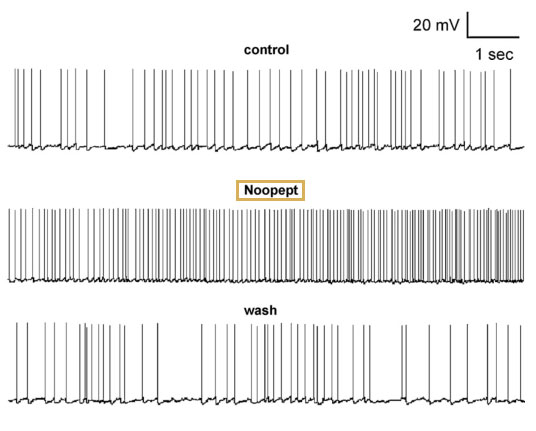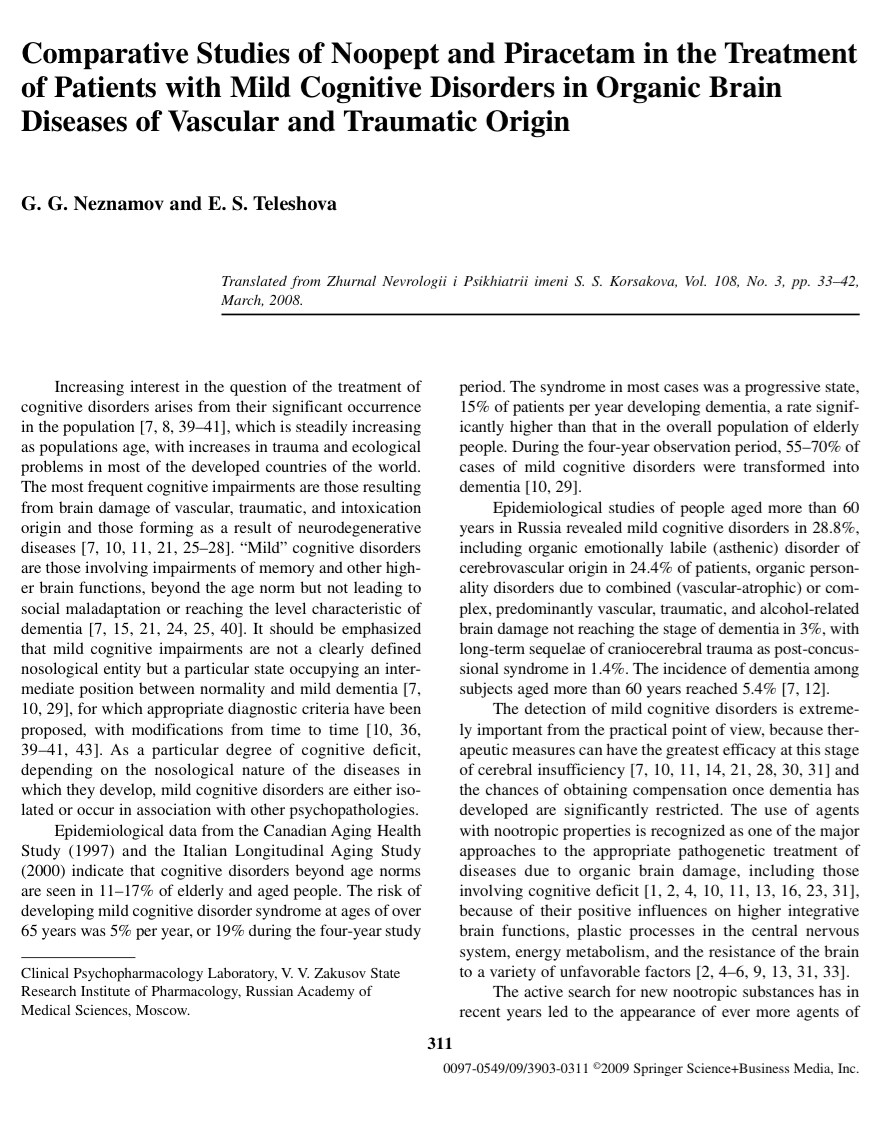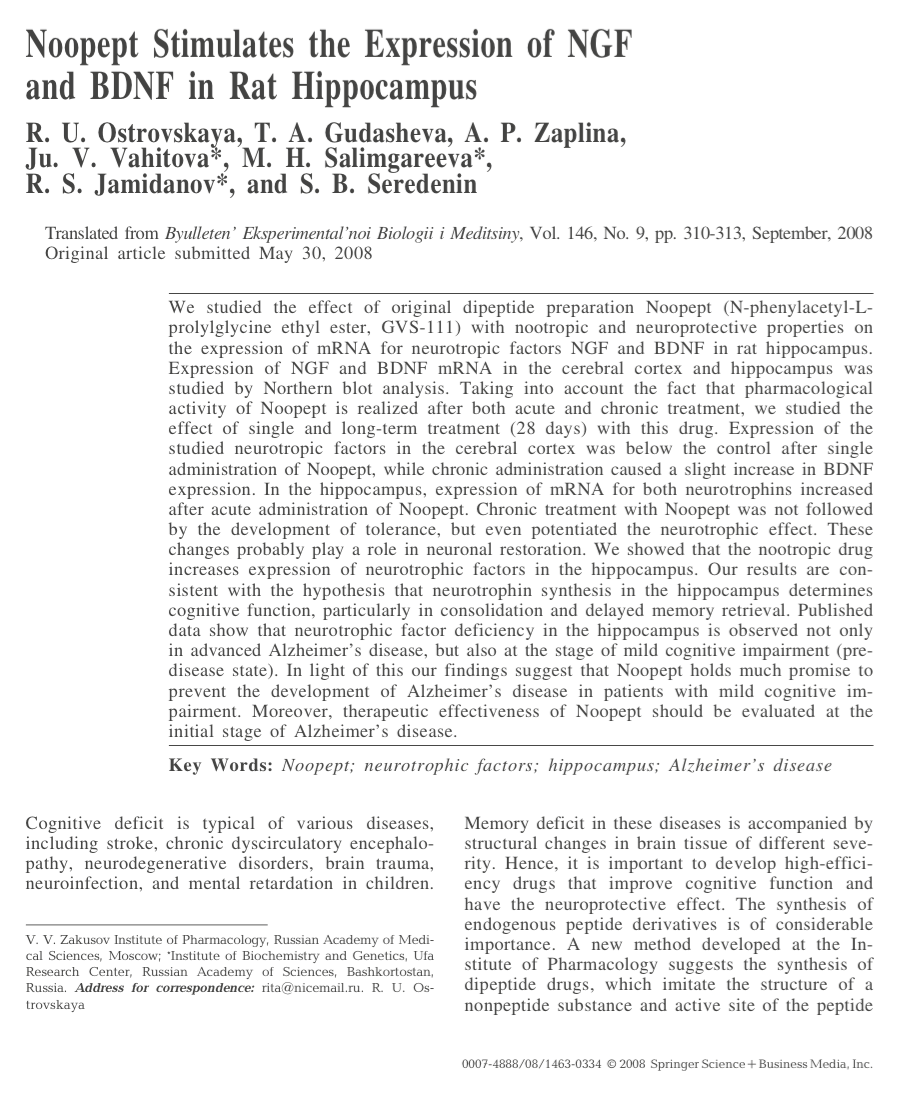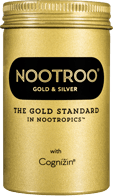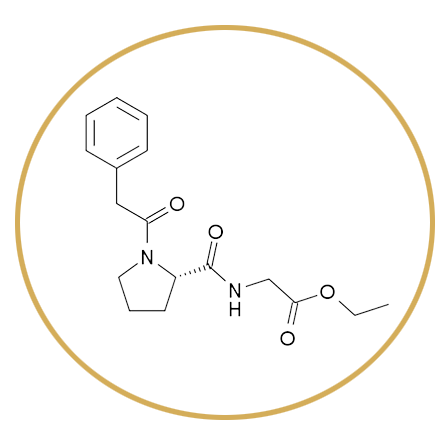 Noopept
Noopept
Noopept was developed to be a more bioavailable (absorbable) version of the original nootropic, piracetam. While piracetam had impressive and unique properties that prompted the creation of the nootropic classification, it had shortcomings in that it requires high doses (multiple grams) and had limitations in the populations it worked on. Noopept on the other hand, was developed specifically to be more powerful in assisting learning and is better at “attenuating the effects of damaging factors on conditioning and memory.” It works at a dose hundreds of times lower than the corresponding dose of piracetam.”[1]Proline-Containing Dipeptide GVS-111 Retains Nootropic Activity after Oral Administration. You can read more about the history of noopept below, but it was developed from the core molecule of piracetam (proline) combined with the structure of a neuropeptide.
Neuropeptides are small molecules that are involved in a wide range of physiological functions and can act as neurotransmitters, neuromodulators or hormones in the central nervous system and in the periphery.[2]Neuropeptides represent by far the most common signaling molecules in the central nervous system. They are involved in a wide range of physiological functions and can act as neurotransmitters, … Continue reading[3]https://en.wikipedia.org/wiki/Neuropeptide. Peptides, however, are typically not able to be taken orally because they are rapidly broken down by the gastrointestinal tract, well before they would be able to enter the blood or cross the blood-brain barrier (BBB) and enter the brain . However, double (di-) and triple (tri-) bonded peptides, have a special transporter (PepT1 ) that gives them a sort of express lane across the gut, where they are able to get into the blood and brain successfully. With this knowledge, a lab in Russia that specialized in creating di- and tri-peptide versions of other molecules, set out to make a more powerful version of piracetam. They created hundreds of variations of dipeptides and one molecule clearly stood out from the pack: known then as GVS-111 and eventually as noopept.
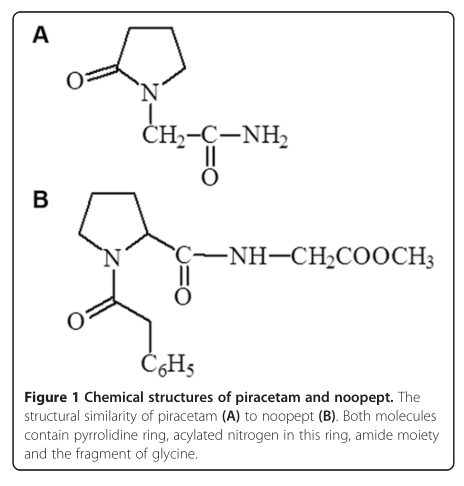
Noopept was selected from the series of peptides because of its:
- Pronounced nootropic activity [4]Ostrovskaya RU, Gudasheva TA, Trofimov SS, Kravchenko EV, Firova FV, Molodavkin GM, Voronina TA, Seredenin SB: GVS-111, an Acylprolyl-Containing Dipeptide With Nootropic Properties. In Biological … Continue reading
- High bioavailability for brain tissues from oral administration [5]Boiko SS, Ostrovskaya RU, Zherdev VP, Korotkov SA, Gudasheva TA, Voronina TA, Seredenin SB: Pharmacokinetics of new nootropic acylprolyldipeptide and its penetration across the blood–brain barrier … Continue reading
- Specificity of its mechanism of action [6]Gudasheva TA, Bojko SS, Voronina TA, Akparov VK, Trofimov SS, Rozantsev GG, Skoldinov AP, Zherdev VP, Seredenin SB: The major metabolite of dipeptide piracetam analogue GVS-111 in rat brain and its … Continue reading
- Demonstrated wide spectrum of cognition improving effects [7]Ostrovskaya RU, Romanova GA, Barskov IV, Shanina EV, Gudasheva TA, Victorov IV, Voronina TA, Seredenin SB: Memory restoring and neuroprotective effects of the proline containing dipeptide, GVS-111, … Continue reading as well as pronounced neuroprotective activities both in vivo [8]Ostrovskaya RU, Romanova GA, Barskov IV, Shanina EV, Gudasheva TA, Victorov IV, Voronina TA, Seredenin SB: Memory restoring and neuroprotective effects of the proline containing dipeptide, GVS-111, … Continue reading and in vitro conditions [9]Pealsman A, Hoyo-Vadillo C, Seredenin SB, Gudasheva TA, Ostrovskaya RU, Busciglio J: GVS-111 prevents oxidative damage and apoptosis in normal and Down’s syndrome human cortical neurons. Int J Dev … Continue reading
- Compared to piracetam noopept produces a cognition-enhancing effect at much lower concentrations and demonstrates activity over a wider range of cognition disturbances and neuronal damages [10]Ostrovskaia RU, Gudasheva TA, Voronina TA, Seredenin SB: The original novel nootropic and neuroprotective agent Noopept. Eksp Klin Farmakol
2002, 65(5):66–72.. - Showed effectiveness in several animal models of AD: olfactory bulbectomy , administration of amyloid into Meinert nucleus and intracerebroventricul administration of diabetogenic toxin streptozotocine [11]Ostrovskaya RU, Tsaplina AP, Vakhitova YV, Salimgareeva MK, Yamidanov RS: Effect of the novel cognition enhancing and neuroprotective dipeptide Noopept on the streptozotocin-induced model of sporadic … Continue reading.
- Experimental data on cognitive improving effect of noopept have been confirmed in clinic (Phase III and postregistration trials) demonstrating beneficial effect on cognitive functions in patients with MCI of cerebro-vascular or posttraumatic origin [12]Neznamov GG, Teleshova ES: Comparative studies of Noopept and piracetam in the treatment of patients with mild cognitive disorders in organic brain diseases of vascular and traumatic origin. Neurosci … Continue reading, and in particular in patients with amnestic form of MCI carrying APOE ε4+ allele [13]Gavrilova SI, Kolihalov IV, Fedorova JB, Kaljn JB, Selezneva ND: Experience of Noopept clinical usage in the treatment of mild cognitive impairment syndrome. Modern Therapie of Psychiatric Disorders … Continue reading.
For these properties, among others, Noopept was selected to power the Nootroo Gold Formula.
Brief History and Theory Behind the Creation of Noopept
The positive effects of neuropeptides on cognitive processes such as cognition, attention, and concentration had been discovered, so scientists set out to find a corrector of cognitive dysfunction among them.[14]Neuropeptides represent by far the most common signaling molecules in the central nervous system. They are involved in a wide range of physiological functions and can act as neurotransmitters, … Continue reading[15]Kaidanovich O, Eldar-Finkelman H: Peptides targeting protein kinases: strategies implications. Physiology 2006, 21:411–418. The problem with neuropeptides such as vasopressin, ACTH, and others is that they have low biological stability and low permeability of the blood-brain barrier, which means that the substances don’t stay intact long enough and even if they do, they are unable to cross from the blood into the brain.[16]“Neuropeptides have drawn special attention as potential multitarget drugs because of their high biological activity (several orders higher than that of nonpeptide ones), availability of … Continue reading[17]Kaidanovich O, Eldar-Finkelman H: Peptides targeting protein kinases: strategies implications. Physiology 2006, 21:411 – 418.
We will see in the next section that the research shows that the di-peptide structure of noopept was, as designed, able to overcome those shortcomings and create one of the most potent and effective nootropics ever discovered.
High Oral Bioavailability

The Russian Academy of Medical Sciences had been working since the mid-1980s to make oligopeptides that were structurally similar to non-peptide molecules. They evaluated piracetam’s structure and performed conformational analysis, which resulted in the creation of a series of di-peptides containing proline. One of those molecules, known then as GVS-111 and eventually as Noopept, was selected because it “exhibited the highest nootropic activity: it improved learning and attenuated the effects of damaging factors on conditioning and memory in doses 3 orders of magnitude lower than the corresponding doses of piracetam.”[18]Proline-Containing Dipeptide GVS-111 Retains Nootropic Activity after Oral Administration.
These scientists found that on the passive avoidance model showed that noopept “stimulated all stages of memory processing, in contrast to piracetam affecting primarily memory acquisition.”[19] R. U. Ostrovskaya, T. A. Gudasheva, S. S. Trofimov, et al., in: Biological Basis of Individual Sensitivity to Psychotropic Drugs, Edinburg, (1994), 79-91.. Noopept is known to almost completely metabolize into a naturally occurring neuropeptide known as cycloprolylglycine (CPG). This CPG neuropeptide has been shown to also have a positive effect on the early stages of memory formation, but when applied repeatedly over time, it usually has a diminishing return. This is similar to the effect of piracetam, however “repeated administrations of [noopept] after active avoidance training compared with the effects of CPG and piracetam” showed that while a single administration of either of them improved learning, only noopept administered in a longer term regimen “increased the number of animals attaining the learning criterion among poor learners.”[20]Proline-Containing Dipeptide GVS-111 Retains Nootropic Activity after Oral Administration
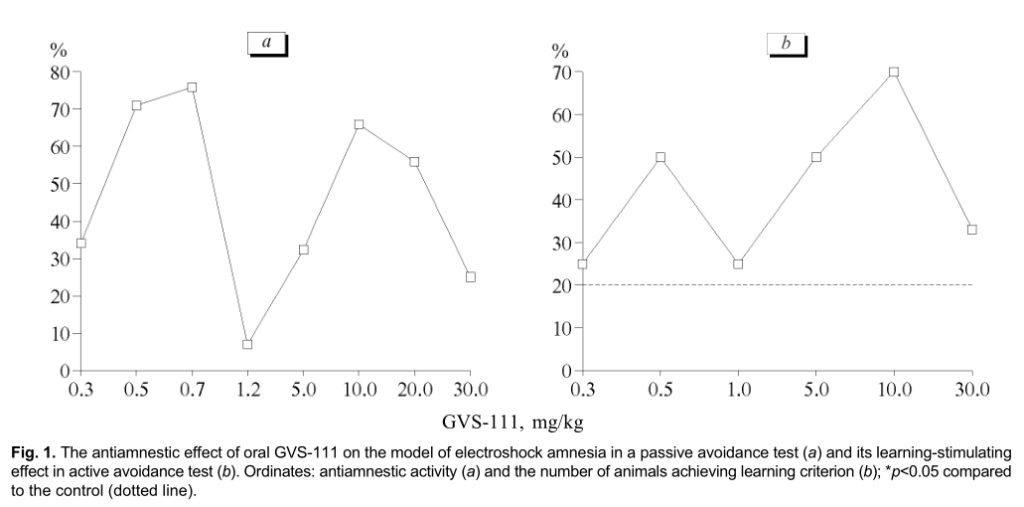
“Oral administration of GVS-111 produced an anti-amnestic effect (above Fig. 1, a). The dose-effect relationship in a 0.3-1.2 mg/kg dose range was described by a bell-shaped curve with a peak at 0.5 – 0.7 mg/kg. The anti-amnestic effect disappeared at a dose of 1.2 mg/kg and appeared again at higher doses. The second peak corresponded to 10 mg/kg, while at 30 mg/kg the anti-amnestic activity decreased. Therefore, the dose-dependence of GVS-111 effect was described by a two-peak curve.”
“Oral GVS-111 dose-dependently increased the number of good learners (above Fig. 1, b). ” A single dose of noopept before training was able to increase the number of animals who achieved the learning criterion from 25% to 60%.
This study offered conclusive results that after oral administration, noopept is “rapidly absorbed and enters systemic and cerebral circulation” and that “its concentration in the brain far exceeds its plasma concentration.” Not only that, but oral noopept in “single and subchronic administration was effective in a passive avoidance test and a version of active avoidance training.” The results show that noopept “stimulated memory consolidation and promoted attaining of learning criterion in poor learner animals.”
So we know that Noopept has excellent bioavailablity, meaning it is readily absorbed, and that when absorbed helps with learning, even when taken after a training event has occurred. In fact, because the evidence shows that noopept can enhance the retention when taken afterwards, it helps confirm “the important role of consolidation processes in completion of learning.”[21]Proline-Containing Dipeptide GVS-111 Retains Nootropic Activity after Oral Administration Next, we will look a little more into the research on what happens in the minutes after noopept enters the brain and then look at the continued improvement in measures of mental performance after weeks of noopept usage.
Single (Acute) Dose Effects
This is the short-term effects of a single dose of piracetam and noopept injected into rats as detected on an EEG.
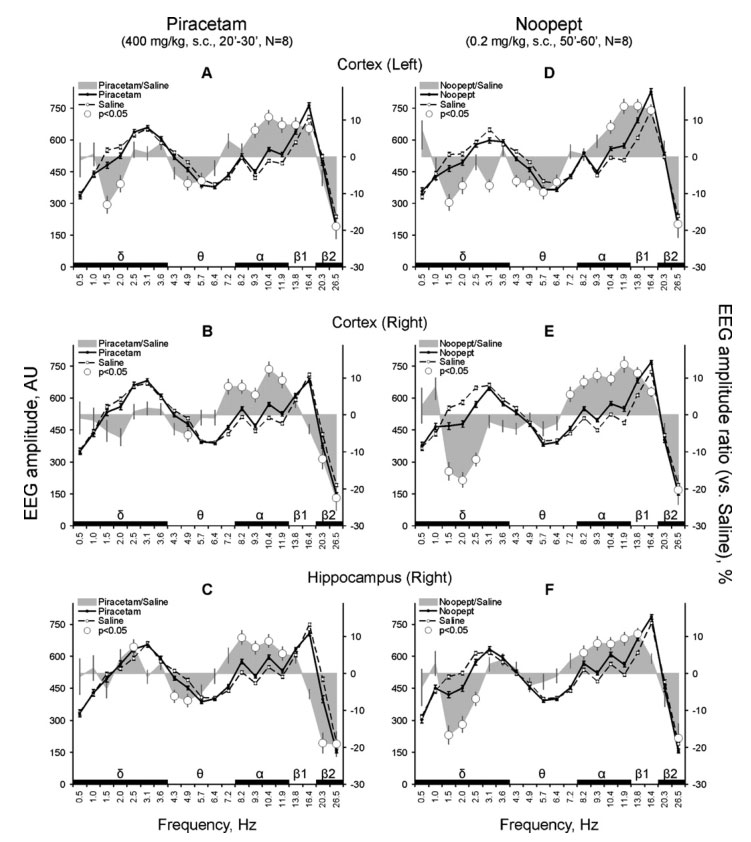
Single Dose Effect on Action Potential of Hippocampal Pyramidal CA1 Receptors
One way noopept acts is by modulating the firing rate of inhibitory interneurons. In this study, the researchers found that noopept increases the inhibitory tone of hippocampal CA1 pyramidal cells by altering the spiking rate of GABAergic inhibitory interneurons. What this shows is that noopept acts in one way by modulating the firing of neurons in the hippocampus.
From the study: “Novel nootropic dipeptide Noopept increases inhibitory synaptic transmission in CA1 pyramidal cells” [22]Novel nootropic dipeptide Noopept increases inhibitory synaptic transmission in CA1 pyramidal cells
Noopept On Adults With Statistically Significant Effects at 14 Days
Over a number of experiments, we have seen that noopept has a quick onset of effects after application as demonstrated with the above experiments utilizing EEGs and hippocampal neuronal firing. Now we will look at when statistically significant effects occurring on adult populations over a longer time longer time-frame, around 7-14 days.
The graph below shows the changes in score on a test called the Cognitive Capacity Screening Examination (CCSE) over time. The CCSE is used to detect cognitive impairment with a 30 question test, with examples such as “Beginning with Sunday, say the days of the week backward” or recalling digits or words given in previous questions.
This study compared the effects of piracetam (left) and noopept (right) treatment on patients with organic cognitive decline (top row labeled A) and patients with post-concussional syndrome (bottom row labeled B). While we saw the evidence of positive short-term changes within minutes of absorption in the prior studies, we can see from these studies statistically significant changes in the brain begin to occur between 7-14 days, and continue increasing for at least 56 days (length of this study).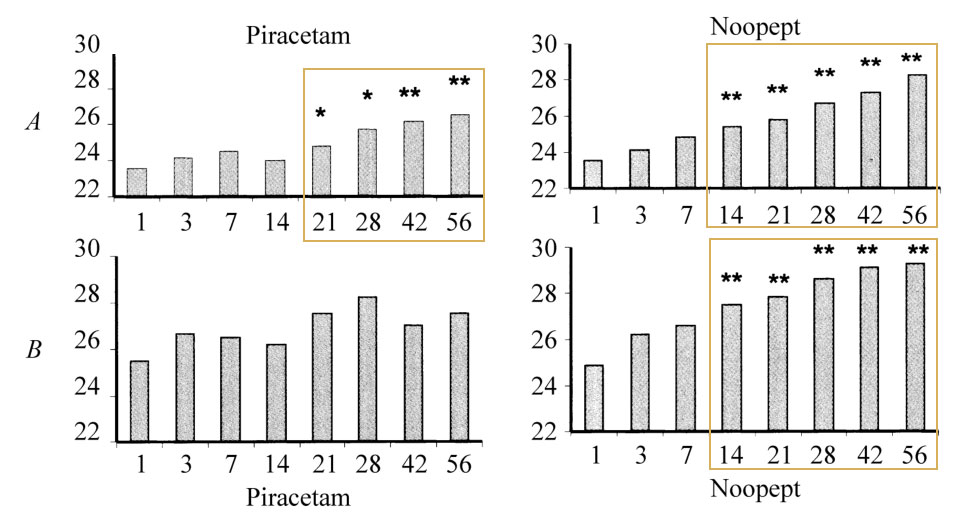
Here are some select quotes from the study titled: Comparative Studies of Noopept and Piracetam in the Treatment of Patients with Mild Cognitive Disorders in Organic Brain Diseases of Vascular and Traumatic Origin:
“The therapeutic actions of the study agents in our patients consisted of decreases in neurosis-like symptomatology and cognitive disorders. On the symptom severity assessment scale, the effects of Noopept in patients with organic emotionally labile (asthenic) disorder of vascular origin were apparent from the first week of treatment, with reductions in increased irritability and affective lability and, probably, weakness-associated emotional tension, with improvements in going to sleep and the depth and duration of nocturnal sleep. From the second week of treatment, there were reductions in increased fatigue, listlessness, weakness, tiring, apathy, and daytime drowsiness; from the third week, there were reductions in anxiety, depressed mood, and hyperesthesia. These changes were accompanied by the autonomic-normalizing action of Noopept, with decreases in the severity of headaches and somato-autonomic symptomatology. The therapeutic dynamics of these neurosis-like symptoms are consistent with previous data showing that the spectrum of action of Noopept includes anxiolytic and psychostimulatory effects.”
“In patients with organic emotionally labile (asthenic) disorder and post-concussional syndrome, Noopept also produced, at 7–14 days of treatment, positive changes in somatoneurological signs”
” During Noopept treatment, virtually all patients with organic emotionally labile (asthenic) disorder of vascular origin showed improvements in measures reflecting the autonomic-normalizing effect of Noopept”
“…the period from 2–4 weeks of treatment was associated with the gradual appearance of the actions of Noopept, with decreases in impairments to attention and memory apparent both in the results of specific testing and social interactions and the effectiveness of daily activities.”
“The effects of Noopept on impairments to cognitive functions in patients with organic emotionally labile (asthenic) disorder and post-traumatic impairments were apparent as statistically significant reductions in scores on the MMSE, BPRS, and CCSE scales, starting from the third week of treatment.”
“Significant positive changes, identifying the nootropic effects of Noopept, starting from 2–3 weeks of treatment, were seen in all BCRS measures in patients with organic emotionally labile (asthenic) disorder of vascular origin; in patients with post-concussional syndrome, improvements were seen in the ability to concentrate and count and in short-term memory for ongoing events and long-term memory for the past.”
“Thus, the use of Noopept in patients with mild cognitive disorders in organic CNS lesions of vascular origin and post-concussional syndrome led to significant reductions in all symptomatology, with decreased manifestations of both cognitive deficit and neurosis-like disorders. The agent had nootropic effects, psychostimulatory actions including anti-asthenic and anxiolytic effects, positive effects on hypothymic disorders and sleep, and autonomic-normalizing actions.”
Pharmakinetics and Absorbtion
Noopept is well-tolerated and has not been shown to cause any disturbances in the body. “GVS-111 [Noopept] is a well-tolerated substance: wile its effective doses are .1-1.2mg/kg, its acute toxicity is shown to be 5000 mg/kg. One-month long GVS-111 [Noopept] administration at doses of .5 and 5.0mg/kg did not cause either morphological or biochemical disturbances, embryotoxicity or teratogenity. [23]Ostrovskaya RU, Romanova GA, Barskov IV, Shanina EV, Gudasheva TA, Victorov IV, Voronina TA, Seredenin SB: Memory restoring and neuroprotective effects of the proline containing dipeptide, GVS-111, … Continue reading
After it crosses the blood-brain barrier, noopept metabolizes (transforms in the body) almost completely into a naturally occurring neuropeptide found endogenously (inside) the brain called cyclo-L-prolylglycine (CPG). When the brains of rats given noopept were analyzed, it was not found after 1 hour, however, scientists found a 2.5-fold increase in CPG.[24]The major metabolite of dipeptide piracetam analogue GVS-lll in rat brain and its similarity to endogenous neuropeptide cyclo-L-prolylglycine. What is interesting though, is that repeated administration of CPG seems to lose its effectiveness, while continued application of noopept, continues to generate an increasing effect.
If anyone tells you that peptides are unable to be absorbed, show them this study which basically tells them to look up PepT1 and its ability to transport proline containing dipeptides. See this study: Molecular interactions between dipeptides, drugs and the human intestinal H+–oligopeptide cotransporter hPEPT1
Studies on Noopept
References
| ↑1, ↑18, ↑20, ↑21 | Proline-Containing Dipeptide GVS-111 Retains Nootropic Activity after Oral Administration |
|---|---|
| ↑2 | Neuropeptides represent by far the most common signaling molecules in the central nervous system. They are involved in a wide range of physiological functions and can act as neurotransmitters, neuromodulators or hormones in the central nervous system and in the periphery. Accumulating evidence during the past 40 years has implicated a number of neuropeptides in various cognitive functions including learning and memory’ Neuropeptides in learning and memory processes with focus on Galanin https://www.researchgate.net/publication/38018241_Neuropeptides_in_learning_and_memory_processes_with_focus_on_galanin |
| ↑3 | https://en.wikipedia.org/wiki/Neuropeptide |
| ↑4 | Ostrovskaya RU, Gudasheva TA, Trofimov SS, Kravchenko EV, Firova FV, Molodavkin GM, Voronina TA, Seredenin SB: GVS-111, an Acylprolyl-Containing Dipeptide With Nootropic Properties. In Biological Basis of Individual Sensitivity to Psychotropic Drugs. Edited by Seredenin SB, Longo V, Gaviraghi G. UK: Graffhan Press Ltd; 1994:79–91. |
| ↑5 | Boiko SS, Ostrovskaya RU, Zherdev VP, Korotkov SA, Gudasheva TA, Voronina TA, Seredenin SB: Pharmacokinetics of new nootropic acylprolyldipeptide and its penetration across the blood–brain barrier after oral administration. Bull Exp Biol Med 2000, 129:359–361 |
| ↑6 | Gudasheva TA, Bojko SS, Voronina TA, Akparov VK, Trofimov SS, Rozantsev GG, Skoldinov AP, Zherdev VP, Seredenin SB: The major metabolite of dipeptide piracetam analogue GVS-111 in rat brain and its similarity to endogenous neuropeptide cyclo-L-prolylglycine. Eur J Drug Metab Pharmacokinet 1997, 22:245–252 |
| ↑7, ↑8 | Ostrovskaya RU, Romanova GA, Barskov IV, Shanina EV, Gudasheva TA, Victorov IV, Voronina TA, Seredenin SB: Memory restoring and neuroprotective effects of the proline containing dipeptide, GVS-111, in a photochemical stroke model. Behav Pharmacol 1999, 10:549–553 |
| ↑9 | Pealsman A, Hoyo-Vadillo C, Seredenin SB, Gudasheva TA, Ostrovskaya RU, Busciglio J: GVS-111 prevents oxidative damage and apoptosis in normal and Down’s syndrome human cortical neurons. Int J Dev Neurosci 2003, 21:117–124. |
| ↑10 | Ostrovskaia RU, Gudasheva TA, Voronina TA, Seredenin SB: The original novel nootropic and neuroprotective agent Noopept. Eksp Klin Farmakol 2002, 65(5):66–72. |
| ↑11 | Ostrovskaya RU, Tsaplina AP, Vakhitova YV, Salimgareeva MK, Yamidanov RS: Effect of the novel cognition enhancing and neuroprotective dipeptide Noopept on the streptozotocin-induced model of sporadic Alzheimer Disease in rats. Eksp Klin Farmakol 2010, 73:2–6 |
| ↑12 | Neznamov GG, Teleshova ES: Comparative studies of Noopept and piracetam in the treatment of patients with mild cognitive disorders in organic brain diseases of vascular and traumatic origin. Neurosci Behav Physiol 2009, 39(3):311–321. |
| ↑13 | Gavrilova SI, Kolihalov IV, Fedorova JB, Kaljn JB, Selezneva ND: Experience of Noopept clinical usage in the treatment of mild cognitive impairment syndrome. Modern Therapie of Psychiatric Disorders 2008, 1:27–32. |
| ↑14 | Neuropeptides represent by far the most common signaling molecules in the central nervous system. They are involved in a wide range of physiological functions and can act as neurotransmitters, neuromodulators or hormones in the central nervous system and in the periphery. Accumulating evidence during the past 40 years has implicated a number of neuropeptides in various cognitive functions including learning and memory’ Neuropeptides in learning and memory processes with focus on…. https://www.researchgate.net/publication/38018241_Neuropeptides_in_learning_and_memory_processes_with_focus_on_galanin |
| ↑15 | Kaidanovich O, Eldar-Finkelman H: Peptides targeting protein kinases: strategies implications. Physiology 2006, 21:411–418. |
| ↑16 | “Neuropeptides have drawn special attention as potential multitarget drugs because of their high biological activity (several orders higher than that of nonpeptide ones), availability of several recognizing sites supposed to be complementary to various targets, the ability to interact with different signal molecules, and minimal side effects. However, their usage as drugs is hindered by the poor blood-brain barrier penetration and low biological stability ” |
| ↑17 | Kaidanovich O, Eldar-Finkelman H: Peptides targeting protein kinases: strategies implications. Physiology 2006, 21:411 – 418. |
| ↑19 | R. U. Ostrovskaya, T. A. Gudasheva, S. S. Trofimov, et al., in: Biological Basis of Individual Sensitivity to Psychotropic Drugs, Edinburg, (1994), 79-91. |
| ↑22 | Novel nootropic dipeptide Noopept increases inhibitory synaptic transmission in CA1 pyramidal cells |
| ↑23 | Ostrovskaya RU, Romanova GA, Barskov IV, Shanina EV, Gudasheva TA, Victorov IV, Voronina TA, Seredenin SB: Memory restoring and neuroprotective effects of the proline containing dipeptide, GVS-111, in a photochemical stroke model. Behav Pharmacol 1999, 10:549 – 553. |
| ↑24 | The major metabolite of dipeptide piracetam analogue GVS-lll in rat brain and its similarity to endogenous neuropeptide cyclo-L-prolylglycine |
